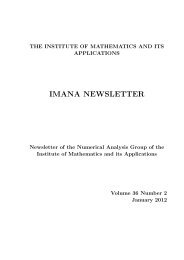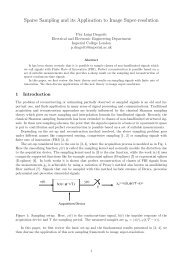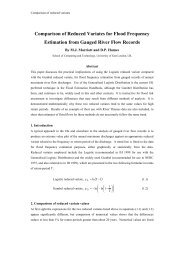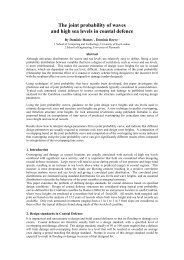An Adaptive Linear Equalizer With Optimum Filter Length and ...
An Adaptive Linear Equalizer With Optimum Filter Length and ...
An Adaptive Linear Equalizer With Optimum Filter Length and ...
Create successful ePaper yourself
Turn your PDF publications into a flip-book with our unique Google optimized e-Paper software.
<strong>An</strong> <strong>Adaptive</strong> <strong>Linear</strong> <strong>Equalizer</strong> <strong>With</strong> <strong>Optimum</strong> <strong>Filter</strong> <strong>Length</strong><br />
<strong>and</strong> Decision Delay<br />
Yu Gong<br />
School of Systems Engineering<br />
University of Reading,<br />
Reading RG6 6AY, UK<br />
Colin F. N. Cowan <strong>and</strong> Jian Chen<br />
The ECIT Institute<br />
Queen’s University of Belfast<br />
Belfast BT3 9DT, UK.<br />
Abstract<br />
The power of an adaptive equalizer is maximized when the structural parameters including<br />
the tap-length <strong>and</strong> decision delay can be optimally chosen. Although the method for adjusting<br />
either the tap-length or decision delay has been proposed, adjusting both simultaneously<br />
becomes much more involved as they interact with each other. In this paper, this problem is<br />
solved by putting a linear prewhitener before the equalizer, with which the equivalent channel<br />
becomes maximum-phase. This implies that the optimum decision delay can be simply fixed<br />
at the tap-length minus one, while the tap-length can then be chosen using a similar approach<br />
as that proposed in our previous work.<br />
1 Introduction<br />
In a classic design of the linear adaptive equalizer, the structure parameters, including the filter<br />
length <strong>and</strong> decision delay, are usually fixed to some compromise values, implying that often the<br />
equalizer is too long <strong>and</strong> sometimes inadequate for the severity of conditions, <strong>and</strong> furthermore, the<br />
resource may not be best utilized unless the fixed decision delay happens to be (which rarely does)<br />
the optimum value that minimizes the MMSE.<br />
In our previous work, we have proposed algorithms to adapt either the filter length [GC05b]<br />
or the decision delay [GC05a] by fixing one of them. While the length adaptation was successfully<br />
implemented, however, the proposed delay adaptation suffers from slow convergence under<br />
some scenarios. Up to now, the objective of the structure adaptation is only partially achieved as<br />
eventually the length <strong>and</strong> delay need to be adjusted simultaneously. In a recent paper [GC06], we<br />
proposed a new method to optimally chose the filter length <strong>and</strong> decision delay simultaneously for<br />
the decision feedback equalizer (DFE). Ironically, although the linear equalizer appears to have a<br />
simpler structure than the DFE, it bears more difficult to adjust the tap-length <strong>and</strong> decision delay.<br />
Thus the approaches developed for the DFE cannot be directly applied.<br />
In this paper, we solve this problem by adding a linear pre-whitener prior to the equalizer, with<br />
which the channel becomes maximum-phase. We can then circumvent the difficulty of the delay<br />
adaptation by fixing the delay at the filter length minus one <strong>and</strong> only apply the length adaptation<br />
to the equalizer. Although this brings up a new problem of choosing an appropriate length for the<br />
pre-whitener itself, it can be relatively easily tackled. Assuming a moving average model of the<br />
channel, a feedback pre-whitener needs only to be as long as the channel memory, while the channel<br />
memory can be obtained by traditional order selection criteria (e.g. [RR97, Aka74]). Although
adding a pre-whitener slightly increases the complexity, the cost is justified since a pre-whitener is<br />
often used to improve the convergence of the equalizer as well.<br />
2 <strong>Linear</strong> Prewhitener<br />
Assuming the channel is causal with finite length of N h , we obtain the channel output as:<br />
y(n) = Hs(n) + n(n), (1)<br />
where H is the channel matrix, s(n) is the transmission vector <strong>and</strong> n(n) is the noise vector. <strong>With</strong>out<br />
losing generality, we assume E[s 2 (n)] = 1.<br />
It is known [Qur85] that the optimum MMSE linear equalizer is given by<br />
W (z) =<br />
H ∗ (1/z ∗ )<br />
H(z)H ∗ (1/z ∗ ) + σ 2 , (2)<br />
where H(z) is the channel transfer function <strong>and</strong> σ 2 is the noise power. The denominator of (2) can<br />
be decomposed as<br />
H(z)H ∗ (1/z ∗ ) + σ 2 = F (z)F ∗ (1/z ∗ ), (3)<br />
where F (z) <strong>and</strong> F (1/z ∗ ) contain only the zero inside <strong>and</strong> outside the unit circle respectively. Then<br />
(2) can be written as:<br />
W (z) = A(z) · B(z), (4)<br />
where<br />
A(z) = 1<br />
F (z) , B(z) = H∗ (1/z ∗ )<br />
F ∗ (1/z ∗ )<br />
Eq. (4) - (5) implies that when a linear prewhitener, A(z), is placed before the equalizer B(z),<br />
the equivalent channel becomes “maximum-phase”, i.e. all of the channel zeros are outside the<br />
unit circle. Thus the optimum decision-delay is simply N − 1, where N is the tap-length. It is<br />
clear from (5) that the linear prewhitener can be either a feedback filter with length N h or an<br />
infinitely long feedforward filter. Although the feedforward filter is more stable, from the structure<br />
adaptation point of view, it is preferable to use the feedback filter since its length is just N h which<br />
can be obtained by, for example, channel order estimation [Aka74]. Since the prewhitener is in<br />
fact a self-adapted linear predictor with no training symbols required, its length can also be on-line<br />
adapted using the approach proposed in [GC05b]. From this point of view, both the feedback <strong>and</strong><br />
feedforward prewhitener can be applied. To focus on the main point, in this paper, we only consider<br />
the feedback prewhitener <strong>and</strong> assume the channel order is a priori known. We note that the idea<br />
of putting a prewhitener before the equalizer was also reported in [LML98] but not for structural<br />
adaptation, which is the main goal of this paper.<br />
3 Variable <strong>Length</strong> <strong>Equalizer</strong><br />
In this section, we describe how the tap-length of the equalizer after the prewhitener is chosen.<br />
Theoretically a maximum-phase channel requires an infinitely long transversal equalizer. Too long<br />
a filter, however, not only complicates the design with little performance benefit, but also introduces<br />
more adaptation noise. To make it worse, since the time lag is fixed at N − 1, a very long taplength<br />
also means a very long time lag which then renders the equalizer impractical, if not useless.<br />
From the performance point of view, we need to chose an appropriate filter length to balance the<br />
performance <strong>and</strong> the complexity.<br />
First, we define the optimum tap-length. Recall that the equivalent channel is maximum phase,<br />
so the optimum delay ∆ is fixed at N − 1. This implies that when the filter length is very large, the<br />
(5)
first several coefficients of the filter are very small. Thus the difference between the final MMSE<br />
<strong>and</strong> the so-called “segment MMSE” can be used as a measure to indicate whether the equalizer is<br />
long enough or not. The “segment MMSE” is defined as<br />
ξ {N−K} E|e{N(n)−K} 2 (n)| (6)<br />
where e {N−K} (n) s(n − ∆) − w T K+1:N · y K+1:N(n), K is a positive integer much smaller than N,<br />
<strong>and</strong> w K+1:N <strong>and</strong> y K+1:N (n) consist of the last N − K coefficients of the equalizer w <strong>and</strong> inputvector<br />
y(n) respectively. K is set to avoid local minima corresponding to zero channel taps. Then<br />
similar to that in [GC05b], the optimum tap-length, N ′ opt, can be defined as the minimum N that<br />
satisfies:<br />
ξ {N−K} − ξ {N} < E ′ , (7)<br />
where E ′ is a smaller positive constant.<br />
As in [GC05b], we define n f (n) as the pseudo-fractional tap-length which can take fractional<br />
values. Then the length adaptation rule becomes:<br />
[<br />
]<br />
n f (n + 1) = (n f (n) − α) − γ · e{N(n)} 2 (n) − e {N(n)−K} 2 (n) , (8)<br />
where both α <strong>and</strong> γ are small positive numbers. Specifically, α is an additive leaky factor which is<br />
used to prevent the length adapting to unnecessarily large values, <strong>and</strong> γ is the step-size parameter for<br />
the above adaption rule. To ensure stability, we must have α ≪ γ. Initially we have n f (0) = N(0).<br />
The “true” tap-length N(n) is determined according to:<br />
{<br />
⌊nf (n)⌋, |N(n) − n<br />
N(n + 1) =<br />
f (n)| M<br />
N(n), otherwise<br />
(9)<br />
where ⌊.⌋ rounds the embraced value to the nearest integer. If N(n) is to be increased, then M<br />
number of zeros are padded at the head of the equalizer. Otherwise if N is to be decreased, the<br />
first M coefficients of the equalizer are taken out. It can verify that, if α/γ = E ′ , (8) converges to<br />
within a range of (N<br />
f, ′ opt − M, N f, ′ opt<br />
+ M) in the mean.<br />
4 Simulations<br />
In the simulation below, we assume the channel vector is given by h = [0.1 0.3 1 0.3 0.1] T , the<br />
SNR= 20dB, <strong>and</strong> a feedback prewhitener with length of 5 is placed before the equalizer. Fig. 1<br />
plots the MMSE vs. decision-delay for different tap-lengths. For clarification, only the curves for<br />
tap-length at 3, 6, 9 <strong>and</strong> 11 are shown. Two observations can be made: First, for every tap-length,<br />
the optimum decision-delay is N − 1, which verifies our previous analysis that a prewhitener makes<br />
the channel maximum-phase; Second, as long as the tap-length is equal to or larger than 6, the<br />
minimum MMSE can always be reached with ∆ = N − 1. Thus it is not necessary to have any<br />
linear equalizer longer than 6 in this example.<br />
Fig. 2 plots the length learning curves of the linear equalizer, where it is clearly shown that the<br />
tap-length adapts to around the optimum value, i.e. 6, regardless whether the initial tap-length is<br />
3 or 20.<br />
References<br />
[Aka74] H. Akaike. A new look at the statistical model identification. IEEE Trans Automat.<br />
Contr, AC-19:716 – 723, Dec. 1974.
10 0 N=11<br />
N=3<br />
N=6<br />
N=9<br />
MSE<br />
10 −1<br />
10 −2<br />
0 2 4 6 8 10 12 14 16 18<br />
Decision Delay ∆<br />
Figure 1: The MMSE performance of the linear equalizer with a feedback prewhitener.<br />
20<br />
18<br />
N(0) = 3<br />
N(0) = 20<br />
16<br />
14<br />
Tap length N<br />
12<br />
10<br />
8<br />
6<br />
4<br />
2<br />
0 500 1000 1500 2000 2500 3000<br />
Number of symbols<br />
Figure 2: The learning curve of the length adaptation.<br />
[GC05a] Y. Gong <strong>and</strong> C. F. N. Cowan. Equalization with adaptive time lag. IEE Proceedings -<br />
Communications, 152(5):661 – 667, Oct. 2005.<br />
[GC05b] Y. Gong <strong>and</strong> C. F. N. Cowan. <strong>An</strong> LMS style variable tap-length algorithm for structure<br />
adaptation. IEEE Trans. on Signal Processing, 53(7):2400 – 2407, July 2005.<br />
[GC06]<br />
Y. Gong <strong>and</strong> C. F. N. Cowan. A self-constructed adaptive decision feedback equalizer.<br />
IEEE Signal Processing Letters, 13(3):169 – 172, March 2006.<br />
[LML98] J. Labat, O. Macchi, <strong>and</strong> C. Laot. <strong>Adaptive</strong> decision feedback equalization: can you skip<br />
the training period. IEEE Trans. on Communications, 46(7):921 – 930, July 1998.<br />
[Qur85] S. U. H. Qureshi. <strong>Adaptive</strong> equalization. Proceedings of the IEEE, 73(9):1349 – 1387,<br />
Sept. 1985.<br />
[RR97]<br />
I. A. Rezek <strong>and</strong> S. J. Roberts. Parametric model order estimation: a brief review. In<br />
IEE Colloquium on the Use of Model Based Digital Signal Processing Techniques in the<br />
<strong>An</strong>alysis of Biomedical Signals, pages 3/1–3/6, London, UK, April 1997.


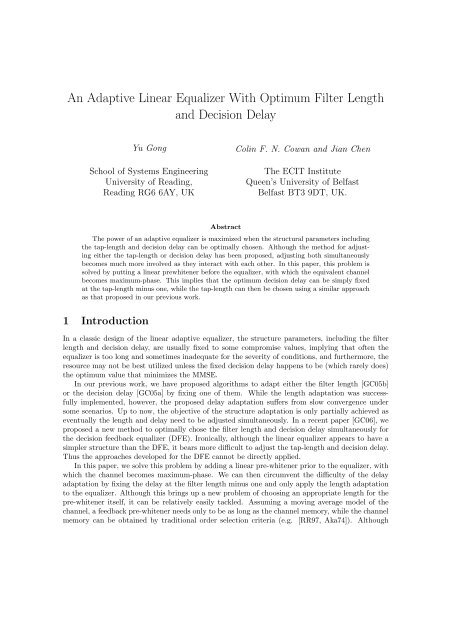
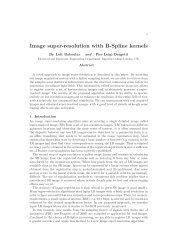

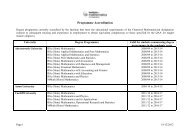
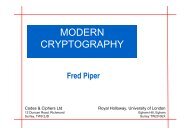
![Download NLAO Application Form [PDF] - Institute of Mathematics ...](https://img.yumpu.com/22617151/1/184x260/download-nlao-application-form-pdf-institute-of-mathematics-.jpg?quality=85)
![Download Education Grants Application Form [PDF] - Institute of ...](https://img.yumpu.com/22617149/1/184x260/download-education-grants-application-form-pdf-institute-of-.jpg?quality=85)
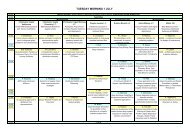
![IMA IPD brochure [PDF] - Institute of Mathematics and its Applications](https://img.yumpu.com/22617139/1/189x260/ima-ipd-brochure-pdf-institute-of-mathematics-and-its-applications.jpg?quality=85)

